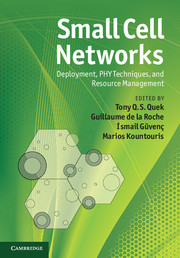Book contents
- Frontmatter
- Contents
- List of contributors
- Foreword by David Chambers
- Acknowledgments
- Acronyms
- 1 Small cell networks overview
- 2 Fundamentals of access control in femtocells
- 3 Coverage analysis using the Poisson point process model
- 4 Interference modeling for cognitive femtocells
- 5 Multiple antenna techniques in small cell networks
- 6 Physical layer techniques for cognitive femtocells
- 7 Femtocell coverage optimization
- 8 Random matrix methods for cooperation in small cell networks
- 9 Mobility in small cell networks
- 10 Cognitive radio resource management in autonomous femtocell networks
- 11 Decentralized reinforcement learning techniques for interference management in heterogeneous networks
- 12 Resource allocation optimization in heterogeneous wireless networks
- 13 New strategies for femto-macro cellular interference control
- 14 Femtocell interference control in standardization
- 15 Spectrum assignment and fairness in femtocell networks
- 16 Self-organization and interference avoidance for LTE femtocells
- Index
- References
5 - Multiple antenna techniques in small cell networks
Published online by Cambridge University Press: 05 May 2013
- Frontmatter
- Contents
- List of contributors
- Foreword by David Chambers
- Acknowledgments
- Acronyms
- 1 Small cell networks overview
- 2 Fundamentals of access control in femtocells
- 3 Coverage analysis using the Poisson point process model
- 4 Interference modeling for cognitive femtocells
- 5 Multiple antenna techniques in small cell networks
- 6 Physical layer techniques for cognitive femtocells
- 7 Femtocell coverage optimization
- 8 Random matrix methods for cooperation in small cell networks
- 9 Mobility in small cell networks
- 10 Cognitive radio resource management in autonomous femtocell networks
- 11 Decentralized reinforcement learning techniques for interference management in heterogeneous networks
- 12 Resource allocation optimization in heterogeneous wireless networks
- 13 New strategies for femto-macro cellular interference control
- 14 Femtocell interference control in standardization
- 15 Spectrum assignment and fairness in femtocell networks
- 16 Self-organization and interference avoidance for LTE femtocells
- Index
- References
Summary
Introduction
Multiple input multiple output (MIMO) communication has been established both theoretically and practically as a means to increase data rates and improve reliability in wireless networks. While single input single output (SISO) wireless communication techniques rely on time domain or frequency domain processing to precode and decode the transmitted and received data signals, multiple antenna communication provides an extra spatial dimension to improve the wireless link performance in terms of error rate, coverage, and/or spectral efficiency.
As interest in MIMO communication has grown, upcoming cellular standards have embraced using multiple antennas at the base stations (BSs) and the mobile user terminals to increase the data rates and improve the performance of the radio link [1]. Multiple antennas are also being considered in small cell networks (SCNs) and femtocell networks as a means to improve coverage and manage interference [2, 3]. The development of MIMO techniques for two-tier networks needs to take into account the specific topology of the network, characterized by irregularity in terms of deployment, operation mode (closed access vs. open access), channel state information (CSI) availability, and backhaul connectivity. In this chapter, we provide an overview of MIMO communication techniques in two-tier networks. We present the state of the art in terms of MIMO precoding and coordination techniques to manage interference in heterogeneous networks. We illustrate the various gains and the associated challenges from using linear precoding with perfect and imperfect channel state information at the transmitter (CSIT) in femtocell networks and evaluate the potential role that multi-antenna communication is bound to play in two-tier networks.
- Type
- Chapter
- Information
- Small Cell NetworksDeployment, PHY Techniques, and Resource Management, pp. 96 - 124Publisher: Cambridge University PressPrint publication year: 2013



